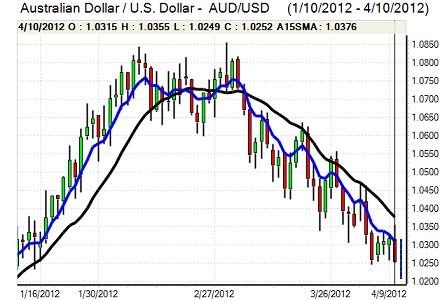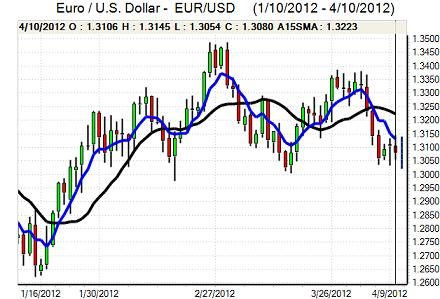EUR/USD
The Euro was unable to hold above the 1.31 level in Europe on Tuesday and dipped to lows around 1.3060 ahead of the US open. Underlying Euro-zone sentiment remained negative with a barrage of negative news for the currency. The economic data was weaker than expected with a decline in the Sentix business confidence index to -14.7 for April from -8.2 previous, in contrast to expectations for a further small improvement.
There was further substantial selling pressure on peripheral bond yields during the session with benchmark Spanish yields approaching the 6.0% level for the first time in over three months while Italian yields also rose. There was a sharp widening in yield spreads as German bund yields equalled record lows on defensive demand. Despite the stresses in bond markets, there was no evidence of ECB bond buying in the secondary market.
There was some speculation that the ECB would have to look for more LTRO operations to help stabilise market conditions, especially with fears that liquidity shortages would re-appear in European banking sector.
There was a general deterioration in risk appetite during the session as equity markets were subjected to renewed selling pressure. The Euro found support at lower levels and briefly moved sharply higher to above the 1.31 level with some reports of sovereign buying. There was speculation of capital repatriation by European commercial banks which may have also provided net Euro support.
There were no major US data releases and comments from regional Fed Presidents were broadly in line with recent remarks. The Euro tended to consolidate around the 1.31 level as the US currency failed to gain any major traction.
Source: VantagePoint Intermarket Analysis Software
Call now and you will be provided with FREE recent forecasts
that are up to 86% accurate* 800-732-5407
If you would rather have the recent forecasts sent to you, please go here
Yen
The dollar was unable to rebound significantly from the 81 area against the yen in Europe on Tuesday and there was renewed downward pressure during New York trading with lows around 80.70.
Both currencies tended to gain support from a deterioration in risk appetite with the Euro retreating to below the 106 level for the first time since the middle of February. The yen was able to gain further net support from the decline in US Treasury yields.
There was also some further disappointment that the Bank of Japan did not relax monetary policy further at the latest policy meeting. This was offset by growing speculation that there would be action to expand policy at the late-April policy meeting. The machinery orders data was stronger than expected with a 4.8% increase for March and risk aversion eased slightly which helped the dollar stabilise in Asia on Tuesday, although it was unable to make significant headway.
Sterling
Sterling was unable to hold above 1.59 against the dollar on Tuesday and retreated sharply to lows in the 1.58 area with some evidence of stop-loss selling. There was solid support at lower levels with the currency then generally firmer. The net influence of a stronger dollar was clearly illustrated by Sterling’s firm tone against the Euro and the trade-weighted index advanced to a 13-month high.
There was speculation over defensive demand as investors sought refuge from the Euro-zone structural fears. There was also a slightly more optimistic tone surrounding UK economic sentiment. The latest BRC retail sales data recorded a 1.3% increase in the year to March from -0.3% previously.
Swiss franc
The dollar initially rallied strongly to a peak just above the 0.92 level against the Swiss franc on Tuesday and attacked this level again in US trading with choppy trading conditions. The Euro was unable to make any significant progress against the franc as it remained trapped close to the 1.2010 level.
There was further speculation that the franc was gaining support from fear surrounding the Euro-zone outlook. National Bank interim Chairman Jordan reiterated that the bank would defend the 1.20 minimum level with all available force. He admitted that trading below the 1.20 level could not be excluded on technical grounds, but that the bank was continuing to sell unlimited quantities of francs at that level.

Source: VantagePoint Intermarket Analysis Software
Call now and you will be provided with FREE recent forecasts
that are up to 86% accurate* 800-732-5407
If you would rather have the recent forecasts sent to you, please go here
Australian dollar
The Australian dollar was unable to hold above the 1.03 level against the US dollar during Tuesday and was subjected to further selling pressure during the day with lows just below the 1.0250 level. The currency was undermined by a general deterioration in risk appetite as equity markets remained on the defensive with a fifth successive daily decline.
There were also persistent doubts surrounding the Asian outlook which curbed demand for the Australian dollar. The domestic data remained uninspiring with a further 2.5% decline in home loans while there was also another decline in consumer confidence. The Australian currency initially remained under pressure with lows near 1.0220 before a recovery back to near 1.03 as short covering gained momentum.




